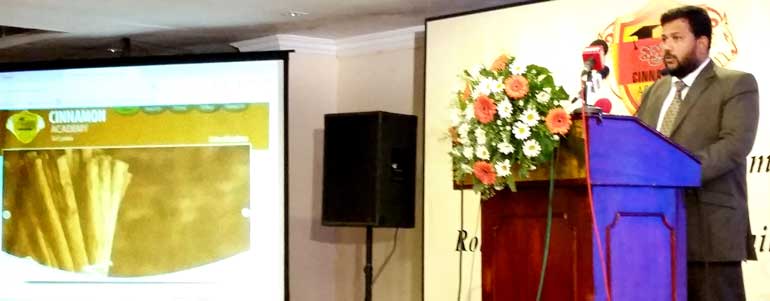Wednesday Feb 26, 2025
Wednesday Feb 26, 2025
Thursday, 24 September 2015 00:00 - - {{hitsCtrl.values.hits}}
 Minister of Industry and Commerce Rishad Bathiudeen addressing the ‘Future Trends in the Cinnamon Industry – Role of the Cinnamon Training Academy’ session on 22 September in Colombo
Minister of Industry and Commerce Rishad Bathiudeen addressing the ‘Future Trends in the Cinnamon Industry – Role of the Cinnamon Training Academy’ session on 22 September in Colombo
A 400,000 strong workforce and a host of exporters are behind Ceylon Cinnamon brand’s global recognition and it is time that higher-end developments are also made in relation to Ceylon Cinnamon,
“Let us not forget the most important stakeholders of this sector. They are the more than 400,000 committed cinnamon workforce and 150 Lankan exporters of cinnamon,” said Minister of Industry and Commerce Rishad Bathiudeen, addressing the ‘Future Trends in the Cinnamon Industry – Role of the Cinnamon Training Academy; held in Colombo with the participation of top industry leaders, producers and exporters.
The Cinnamon Training Academy website was unveiled by Bathiudeen at this event. Also taking part was International Trade Promotion Deputy Minister Sujeewa Senasinghe.
“Today is an important day in Sri Lanka’s historic spice trade,” said Bathiudeen. “Our Cinnamon Training Academy is the only such academy in the world. As we launch the Cinnamon Training Academy website and witness the exchange of the industry MoU, let us also not forget the most important stakeholders of this sector. Thanks to their commitment today Pure Ceylon Cinnamon is a global brand. The Government of President Maithripala Sirisena and Prime Minister Ranil Wickremesinghe continues to follow the steps to improve the global image of Pure Ceylon Cinnamon brand as proposed by our own industry.
“The Cinnamon Training Academy that we talk about today is a result of one such commendable industry initiative. Among the other steps are technology upgrading schemes and Geographical Indicator for Ceylon Cinnamon. In April 2014, as the Minister of Industry and Commerce I also awarded the first official Pure Ceylon Cinnamon brand licenses to our proud batch of Lankan exporters. The successful recipients were nine leading Lankan cinnamon exporting firms. I am pleased to say that the Ministry has also taken other important initiatives to develop not only cinnamon but even the overall spice sector. We enlisted many companies including several spice firms to support them to obtain ISO 22000 certifications.
“Another project was ‘Enhancing the cinnamon value chain in Sri Lanka’ implemented through the Spice Council. It was aimed at developing a suitable training system to train the industry personnel on manufacturing cinnamon according to international practices. With the valuable support of WTO this project was one of the biggest projects to upgrade the Sri Lankan spice industry. Its objective was to facilitate the smallholders to upgrade their processing centres to obtain ISO 22000 and HACCP certifications.
“I believe that these efforts at the lower end alone are not sufficient. Higher-end developments too are necessary. For example if the packaging is not strong and attractive our drive to international markets could fail. In fact the Ministry encourages our packaging sector to produce relevant material in this regard. As a result, we believe that low shelf life ‘medium barriers’ and also ‘high shelf life’ and ‘high barrier packaging’ are more useful for our cinnamon and spice packaging. And the Ministry encourages such packaging.”
Annually Sri Lanka produces about 15,000 metric tons of true cinnamon. Sri Lanka is also aiming at $ 1 b spice and cinnamon exports by 2020.
Discover Kapruka, the leading online shopping platform in Sri Lanka, where you can conveniently send Gifts and Flowers to your loved ones for any event including Valentine ’s Day. Explore a wide range of popular Shopping Categories on Kapruka, including Toys, Groceries, Electronics, Birthday Cakes, Fruits, Chocolates, Flower Bouquets, Clothing, Watches, Lingerie, Gift Sets and Jewellery. Also if you’re interested in selling with Kapruka, Partner Central by Kapruka is the best solution to start with. Moreover, through Kapruka Global Shop, you can also enjoy the convenience of purchasing products from renowned platforms like Amazon and eBay and have them delivered to Sri Lanka.
Discover Kapruka, the leading online shopping platform in Sri Lanka, where you can conveniently send Gifts and Flowers to your loved ones for any event including Valentine ’s Day. Explore a wide range of popular Shopping Categories on Kapruka, including Toys, Groceries, Electronics, Birthday Cakes, Fruits, Chocolates, Flower Bouquets, Clothing, Watches, Lingerie, Gift Sets and Jewellery. Also if you’re interested in selling with Kapruka, Partner Central by Kapruka is the best solution to start with. Moreover, through Kapruka Global Shop, you can also enjoy the convenience of purchasing products from renowned platforms like Amazon and eBay and have them delivered to Sri Lanka.